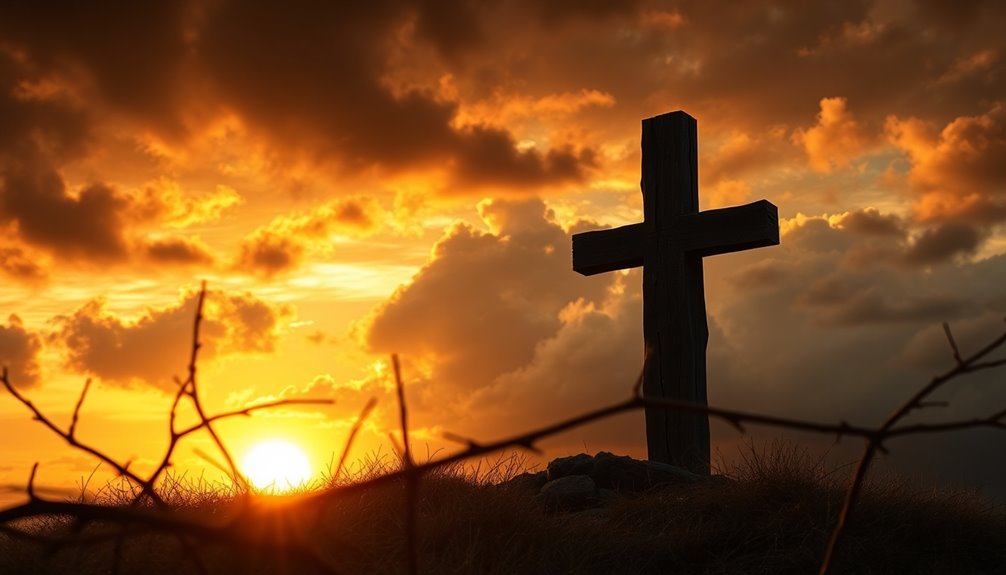The crucifixion of Jesus is a defining moment in history, reflecting both immense suffering and divine purpose. Nailed to the cross, He endured six hours of agony, experiencing mocking and despair. His last words, "My God, my God, why have you forsaken me?" reveal profound sorrow. When He breathed His last, the temple curtain tore, symbolizing a new connection between humanity and God. This event promises salvation and hope for believers, leading to a powerful resurrection story.
At 9:00 AM, Jesus was crucified at Golgotha, a site ominously known as "The place of the skull." For six agonizing hours, he hung on the cross, enduring immense suffering while being mocked and offered vinegar mixed with myrrh. Stripped of his clothing and nailed to the cross, Jesus was positioned between two criminals, with a sign above him declaring him "Jesus of Nazareth, King of the Jews." This proclamation, meant to ridicule him, ironically highlighted his true identity and mission.
As you follow the narrative, you can feel the intensity of the moment. At noon, a heavy darkness enveloped the land, lasting three hours. In this profound silence, you hear Jesus cry out, "My God, my God, why have you forsaken me?" This cry reveals not only his deep agony but also fulfills ancient prophecy, underscoring the gravity of his sacrifice. The atmosphere was thick with despair as the crowd watched, some in disbelief, others in anger.
When Jesus finally breathed his last at approximately 3:00 PM, the earth trembled beneath him. An earthquake shook the ground, and at that very moment, the temple curtain was torn in two from top to bottom. This event signified a pivotal shift in the spiritual realm, symbolizing that through Jesus' sacrificial death, direct access to God was made possible for everyone. The tearing of the curtain represented the end of separation between humanity and the divine, marking the pathway to salvation.
You can't overlook the theological implications of Jesus' crucifixion. His death is viewed as a planned act of atonement for the sins of humanity, laying the foundation for Christian beliefs. In that moment of agony, Jesus bore the weight of the world's transgressions, fulfilling the role of the ultimate sacrifice. His death wasn't just a tragic event; it was the culmination of a divine plan aimed at restoring the broken relationship between God and humanity.
Moreover, the resurrection that followed three days later solidified the victory over sin and death. It served as the promise of eternal life for all who believe. The crucifixion at Golgotha, marked by suffering and darkness, ultimately ushered in the light of hope and salvation through Jesus Christ.
Frequently Asked Questions
What Are the Steps of Jesus' Crucifixion?
To understand the steps of Jesus' crucifixion, you need to know he was first arrested and tried.
After facing mockery and punishment, he carried his cross, with help from Simon.
At Golgotha, he was nailed to the cross between two criminals, and a sign was placed above him.
As darkness fell, he cried out in despair.
Finally, he died, leading to significant events that followed, marking a profound moment in history.
Where Does It Say in the Bible That Jesus Died on the Cross?
In the Bible, you'll find accounts of Jesus' death in all four Gospels.
Matthew 27:50 states, "And when Jesus had cried out again in a loud voice, he gave up his spirit."
Mark 15:37 echoes this, confirming his death.
Luke 23:46 shares Jesus' last words, and John 19:30 says, "It is finished," right before he dies.
Each passage highlights the significance of this pivotal moment in Christian faith.
How Was Jesus Crucified on the Cross?
While the sun blazed above, darkness enveloped the land as you witness the brutal act of crucifixion.
Jesus was nailed to a wooden cross, enduring immense pain while surrounded by jeering crowds. Simon of Cyrene helped him carry the heavy burden, a stark contrast to the mocking soldiers casting lots for his robe.
His final words pierced the silence, echoing with despair, as the earth shook, marking the end of his agonizing ordeal.
Why Did They Break Their Legs During Crucifixion?
During crucifixion, they broke victims' legs to hasten death.
Without the ability to push up, victims couldn't breathe properly, leading to asphyxiation. This method ensured a quicker execution, especially before significant Jewish festivals when the land needed to remain undefiled.
By breaking legs, the soldiers expedited the process, preventing prolonged suffering.
It was a brutal but efficient way to carry out the sentence, ensuring the victims died swiftly.
Conclusion
In the grand tapestry of human history, Jesus' crucifixion stands as a monumental event that reshaped the world. His sacrifice on the cross isn't just a story of suffering; it's a beacon of hope that echoes through the ages. You can't underestimate the impact of such a profound act—it's as if time itself paused to witness love's ultimate triumph over despair. Embracing this legacy invites you to reflect on your own journey and the power of redemption in your life.










